The Panasonic TX-P42GT30B is the company’s mid-range 3D Plasma TV for 2011, featuring the 14th generation NeoPlasma (formerly “NeoPDP”) panel with “Infinite Black Pro”, Short-Stroke phosphor material for reduced trailing and 3D crosstalk, and a newly redesigned ultra-slim chassis. The TX-P42GT30B has also been through the THX Display Certification programme for 2D viewing, and new for 2011, for 3D viewing as well. Last year’s Panasonic Plasma displays needed quite a bit of calibration work in order to avoid unwanted colour tints when playing back 3D video, and actually doing this calibration through the 3D Active Shutter glasses required expensive specialised equipment. Hopefully, THX’s certification process will allow all users to watch tint-free 3-dimensional images without the need for extensive picture setup.
<!-- google_ad_client = 'pub-2887677957235196'; google_ad_slot = '4990177225'; google_ad_width = 336; google_ad_height = 280; //-->
Of course, for further picture fine-tuning, the Imaging Science Foundation (ISF) controls are still present, and have been expanded slightly this year. Panasonic’s midrange Viera HDTVs have typically produced excellent picture quality at very reasonable prices, so if the GT30 performs well, then it should be one of the main Plasma televisions to beat this year. Let’s find out how it performs!
Note: The specific model we reviewed was the Panasonic TX-P42GT30B, which denotes the British 3-pin-plug version. The same 3D TV may be sold by retailers such as John Lewis, Comet and Currys, as well as etailers like Amazon and Dixons as the Panasonic TX-P42GT30 or TXP42GT30. Throughout this article, these model numbers may be used interchangeably to refer to the same display.
The findings in this review pertaining to 3D picture quality should not be extrapolated to larger GT30 models, such as the Panasonic TX-P50GT30B or TX-P46GT30B. These GT30s may not exhibit the same 3D resolution limitation witnessed on the TX-P42GT30B, and in theory should deliver a more immersive 3D viewing experience due to their bigger screen sizes.
Jump To: Operation • Calibration • Picture Performance • Conclusion
Although we feel that design isn’t terribly important in the scheme of things, there’s no denying that Panasonic has upped the ante this year. Although we had a look at these HDTV displays at February’s Panasonic convention, we didn’t really acknowledge the improvement until we got a review sample into our test room.
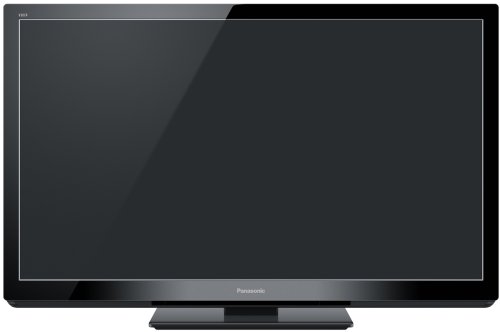
The design of the Panasonic TX-P42GT30B is considerably improved compared to the Viera G20 and GT20 displays that it replaces: it’s thinner, and more subtle and professional looking. The thin border surrounding the sleek-looking glass panel is styled with a brushed steel look, which makes the TX-P42GT30 feel like a smaller version of Panasonic’s professional Plasma displays (which we’ve always envied the design of). The outer edges of the plasma are rounded rather than being square, and there is a small silver border placed between the screen itself and the outer bezel.
In fact, the promotional images Panasonic has issued do the TXP42GT30 a disservice. In pre-rendered publicity pictures, the display looks pretty much the same as every other gloss black TV out there. Don’t judge the GT30’s looks until you see it in the flesh. Less practically, the TX-P42GT30B’s thickness has also been reduced to a mere 3cm (for most of the back panel – the deepest point, at the bottom of the unit, is closer to 5cm).
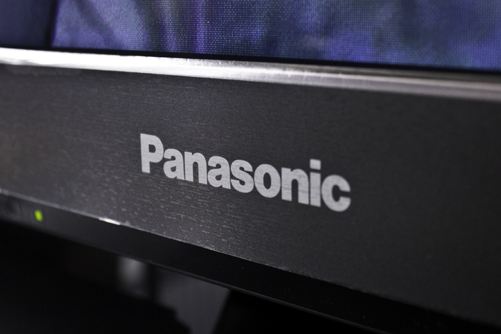
Build quality is also top-notch: no part of the TX-P42GT30B feels cheap or plasticky. It’s probably worthwhile pointing out that the TXP42GT30 does not ship with any 3D glasses, so they will have to be purchased separately if the owner intends to watch extra-dimensional content.
Although we spotted a newly revised remote control design at the company’s annual convention last month, it seems that it’s reserved for high end models only. The mid-range GT30 features a familiar Panasonic remote control, albeit styled in silver. We like this design and have no real issues with it, so aren’t really disappointed – although it looks a little plain when compared to the 3DTV itself. There is now a dedicated “3D” button on the remote control, which is a most welcome addition for European models. Strangely, although the Panasonic TX-P42GT30 features the new “VIERA Connect” online service, the remote control button used to access it still reads “VIERA Cast”. Oops?
The TX-P42GT30B’s design means that, like other manufacturers who have produced ultra-slim displays, Panasonic has had to incorporate the majority of the TV’s video inputs via break-out adapter cables. The exception to this rule is the 4 HDMI inputs, which are slim enough to be built directly in to the back panel. These are mounted facing side-ways to the rear left of the TXP42GT30. Since the HDMI inputs are located quite close to the edge of the rear panel, we found that they would sometimes stick out and remain visible from the front viewing position. Inexpensive L-shaped HDMI adapters or cables could solve this problem, should it become an issue.
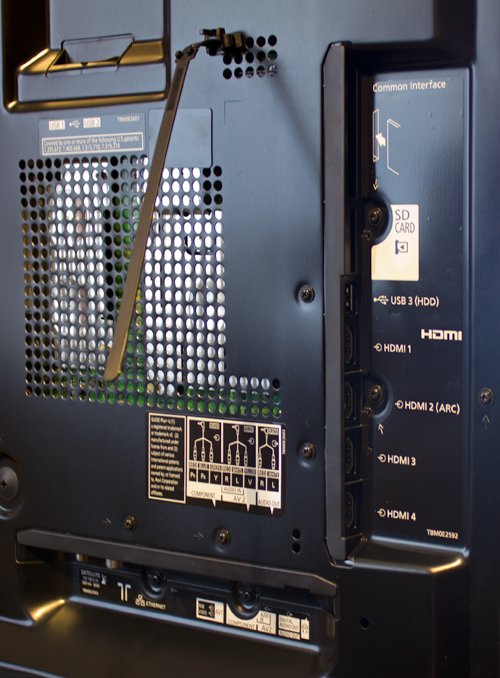 |
| Rear: 4 x HDMI, SCART, Component, aerial, Freesat, ethernet & audio outs |
As for other connectivity options, there’s one RGB SCART input, one Component input, and a nearly useless Composite video input. It seems that the analogue RGB (PC “VGA”) input has been lost in the slimming-down process, but given that most computers can now output via HDMI, we don’t see this as too big an issue.
There are also feeds for the dual tuners on the Panasonic TX-P42GT30B. These are located facing down quite near the bottom of the display, and at first, we were a little wary of forcing the breakout adapter cables into the ports, in case we damaged something. A little force is needed to attach the short extension cables into the tuner inputs, and from there, the appropriate connections can be made.
Panasonic has given most of its lineup a refreshing new menu redesign for 2011. The menus are now drawn in sleek transparent grey, which matches the design of the GT30 itself quite nicely. Some of the menu options have been re-arranged so as to appear in more logical positions: for example, the [3D Settings] screen is now accessed from the [Picture] menu, rather than from a generalised Setup menu. Additionally, with the two “Professional” picture modes, the settings are now accompanied by visible numbers, which is new for the UK variant models and is helpful during the process of finding the best picture settings (which we’ll do in the “Calibration” section).
![[Picture] menu](https://www.hdtvtest.co.uk/news/wp-content/uploads/2018/04/hdtv_Panasonic-TXP42GT30_picture1.jpg) |
![[Picture] menu](https://www.hdtvtest.co.uk/news/wp-content/uploads/2018/04/hdtv_Panasonic-TXP42GT30_picture2.jpg) |
| [Picture] menus |
The [Colour Management] menus introduced last year have been expanded to also include control over the Luminance (Brightness) of the colours, adding the final level of control in addition to the existing adjustments for Saturation and Hue. With last year’s Panasonic flat-screen TVs, we found that even without control over Luminance, there were no huge errors anyway, but more control is always welcome. There are still no adjustments for secondary colours, but we’ll find out later if that’s a big problem or not (our guess is not).
Panasonic has also added Film Cadence Detection to its Plasma televisions this year. On the UK models, this option is called “Clear Cinema”. We’ll find out how well this works later on in the review. Two options to help prevent, or to alleviate Plasma display Image Retention, are also helpfully placed in the picture menu. We’re glad to see an easy shortcut to the “White Scrolling Bar” pattern being made available to users – it’s been present on Panasonic Plasma displays for some time now, but hidden away in the service menu. If you do have a marathon session of TV viewing from a channel with a particularly garish fixed on-screen logo and find it lurking around afterwards, then this “screen wipe” should sort things out.
Note: Our Panasonic TX-P42GT30B review sample was calibrated using Calman Professional, the industry-leading video calibration software.
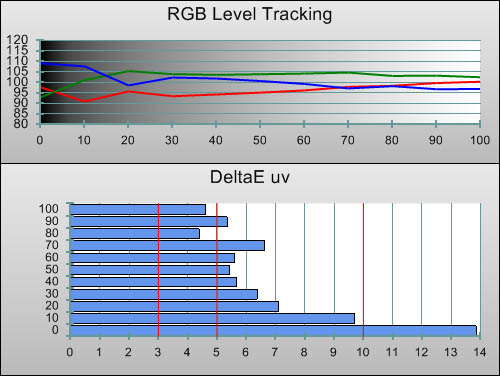 |
| Pre-calibration RGB tracking and delta errors (dEs) |
We allowed our TX-P42GT30B to age for a few days, and then recorded the above measurements from its “THX” picture mode. The image on our TX-P42GT30 review unit had a slight excess of green in the picture, but as we usually find from THX-certified displays, the errors were negligible.
![Post-calibration RGB Tracking in [Professional1] mode](https://www.hdtvtest.co.uk/news/wp-content/uploads/2018/04/hdtv_Panasonic-TXP42GT30_post-rgb.jpg) |
| Post-calibration RGB tracking and dEs in [Professional1] mode |
Cleaning up Greyscale tracking didn’t take long at all, and we were left with the above, highly linear result. We could mention that other HDTV manufacturers are introducing 10-point control (LG has it even on bargain-priced models), but given the quality of the above result, it hardly seems worth mentioning: all stimulus levels except for 10% have a Delta Error of about 2 or less, meaning that the picture will appear free of unwanted tints.
Panasonic’s calibration menus have been improved this year. The on-screen slider control now appears fixed at the bottom of the screen, which is an improvement over last year’s models. On the 2010 displays, the on-screen graphics sometimes covered up the area of the screen that was being read, obviously skewing the measurements. Secondly, the low-end controls seem to have much more scope for adjustment this year: they are much less coarse.
![Gamma curve in [Professional1] mode](https://www.hdtvtest.co.uk/news/wp-content/uploads/2018/04/hdtv_Panasonic-TXP42GT30_post-gamma.jpg) | |
| Gamma curve in [Professional1] mode | Corresponding gamma tracking |
Gamma tracking has never been consistent on any of the Panasonic Plasma TV sets we’ve reviewed. Measurements are strongly influenced by the test patterns being used to gather measurements (compare measurements taken with standard windows compared to smaller patches, for example), indicating some degree of unpredictability as to real-world performance. The above measurements were taken using the small APL windows from the AVSHD calibration disc with the TX-P42GT30’s [Gamma] setting set to “2.2”. As the “Gamma Y” chart indicates, under these conditions, the Panasonic TX-P42GT30B rose out of black slightly too abruptly, over-emphasising shadow detail. As is often the case with Gamma, the user would likely require a perfect “broadcast quality” display (or intimate knowledge of material as viewed on one) to notice any issues.
Although there are still no dedicated controls over the secondary colours (Cyan, Magenta and Yellow), Panasonic has added three-axis control over the Primary colours this year. In other words, we can adjust the Hue and Saturation of Red, Green and Blue (top chart) and new for 2011, also the Luminance of each primary colour, too (bottom chart). The results speak for themselves – although the out-of-the-box performance was very good, the excellent level of control allowed for any colour errors to be further minimised.
![Post-calibration CIE chart in [Professional1] mode](https://www.hdtvtest.co.uk/news/wp-content/uploads/2018/04/hdtv_Panasonic-TXP42GT30_post-cie.jpg) |
| Post-calibration CIE chart with reference to HD Rec.709 |
![Post-calibration Luminance levels in [Professional1] mode](https://www.hdtvtest.co.uk/news/wp-content/uploads/2018/04/hdtv_Panasonic-TXP42GT30_post-colour-lum.jpg) |
| Post-calibration colour luminance (coloured bars = targets; black bars = measured values) |
Panasonic Plasma TVs haven’t had any obvious Greyscale or Colour errors for a while now, so the above results from 2D calibration really weren’t surprising. With 3D, however, it’s a different story. Last year’s first-generation 3D TVs produced a 3D image that was incredibly red-tinted out of the box. Correcting this required a non-contact calibration meter, specialised software, and a good amount of patience – and even then, the post-calibration image wasn’t entirely free of colour tints. Since the TX-P42GT30B has gone through the THX Certification process for both 2D and 3D images, we were enthusiastic to test this 2011 plasma’s out-of-the-box 3D performance.
Even before we began calibrating, we noticed an improvement: the Panasonic GT30 features discrete picture settings for both the 2D and 3D display modes. This is important, because 2D and 3D require different picture settings to both look their best. In other words, make a change to the “Professional1” mode in 3D, switch back to 2D, and you’ll find that your 2D settings have been preserved and the change has only affected the 3D mode. This also means that users no longer have to re-purpose the “Professional2” mode for 3D picture settings and manually change the picture mode upon entering or leaving 3D.
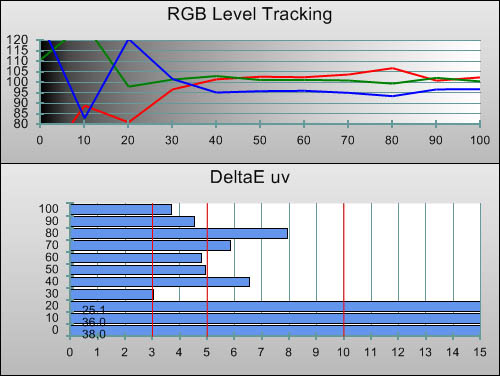 |
| 3D Pre-calibration RGB tracking and delta errors (dEs) |
From casual viewing, we were content that the strong (pre-calibration) red cast to 3D images had been removed this year. We attached a pair of Panasonic TY-EW3D2ME active-shutter 3D glasses to the front of our Klein K-10 meter, engaged 3D mode, selected the “THX” picture preset on the TX-P42GT30B, and then took some Greyscale tracking measurements, the results of which you can see above. Keep in mind that with 3D images, the glasses themselves often have unique tints which vary from pair to pair. In fact, we had access to two separate pairs of Panasonic eyewear during the review process, one of which had a green tint, the other which was slightly blue-tinged. We hope manufacturers will hone in on inaccurate 3D Glasses next!
Back to the 3D Greyscale tracking performance of the [THX] mode: it’s not perfect (at least not with the active-shutter glasses we were using), but it is much, much better than the out-of-the-box 3D performance on the 2010 Panasonic plasmas. For the most part, the mix of Red, Green and Blue did not leave the image looking obviously tinted. Our 20 IRE test pattern measured as being excessively blue, something we confirmed by eye. The fact that the results were largely linear gave us hope that we’d be able to make an improvement with calibration.
![3D Post-calibration RGB Tracking in [Professional1] mode](https://www.hdtvtest.co.uk/news/wp-content/uploads/2018/04/hdtv_Panasonic-TXP42GT30_3d-post-rgb.jpg) |
| 3D Post-calibration RGB tracking and dEs in [Professional1] mode |
Fortunately, we managed to reduce Greyscale tracking errors even further with the [White Balance] menu. The end result is a huge leap over last year’s plasma 3D televisions, and we’d be interested to know what Panasonic has done to improve the Greyscale tracking quality to this extent. 3D images no longer have obvious unwanted colour tints, which rejuvenates our interest in them at a time where we were beginning to get tired of accepting lower quality video in exchange for access to the third dimension. We hope that the process of calibrating 3D TV displays becomes more widespread, because the resulting quality is definitely improved. The only remaining issue for viewing in a family of video enthusiasts is, who gets to wear the most accurate 3D glasses?
The Panasonic TX-P42GT30B didn’t show any obvious colour issues with 3D content prior to calibration, but then again, there’s not much 3D content, and little in the way of a reference! The TXP42GT30’s Colour Management controls can certainly be used to correct Hue and Saturation relative to the HDTV Rec.709 specification:
![3D Post-calibration CIE chart in [Professional1] mode](https://www.hdtvtest.co.uk/news/wp-content/uploads/2018/04/hdtv_Panasonic-TXP42GT30_3d-post-cie.jpg) |
| 3D Post-calibration CIE chart with reference to HD Rec.709 |
The final settings on our Panasonic TX-P42GT30B review unit in both 2D and 3D modes have been published on our Facebook page.
| Dead pixels | One defective pixel in middle-right |
| Screen uniformity | Excellent, but full grey screen reveals slight greenness at right of panel |
| Overscanning on HDMI | 0% with [16:9 Overscan] set to “Off“ |
| Blacker than black | Passed |
| Calibrated black level (black screen) | 0.018 cd/m2 |
| Calibrated black level (ANSI checkerboard) | 0.018 cd/m2 |
| Black level retention | Stable in [THX] mode, some brightness change noticeable otherwise |
| Primary chromaticity | Excellent |
| Scaling | Excellent |
| Video mode deinterlacing | Very effective jaggies reduction |
| Film mode deinterlacing | Passed 2-2 PAL and 3-2 NTSC tests in SD and HD |
| Viewing angle | Excellent, but screen filter lessens vertical viewing angle |
| Motion resolution | 1080, but with noisy edges unless [Intelligent Frame Creation] used |
| Digital noise reduction | [P-NR] has very little effect |
| Sharpness | Defeatable edge enhancement |
| Luma/Chroma bandwidth (2D Blu-ray) | Full Luma, Full Chroma |
| Image retention | Very little |
| Posterization | Mild, though worse with poor source |
| Phosphor trails | Very mild |
| 1080p/24 capability | No judder in 2D or 3D |
| Input lag | 24ms compared to lag-free CRT |
| Full 4:4:4 reproduction (PC) | No, 4:4:4 input subsampled |
| Default [Normal] mode (2D) | 124 watts |
| Default [Normal] mode (3D) | 215 watts |
| Calibrated [Professional1] mode (2D) | 151 watts |
| Calibrated [Professional1] mode (3D) | 215 watts |
| Standby | 1 watt |
Note: Measurements taken with full 50% grey screen.
To our eyes alone, the blacks being put out by the Panasonic TX-P42GT30B appeared incredibly dark, even in a non-light-controlled environment (and let’s face it, that’s where almost all users will be watching the TV). The Plasma panel’s screen filter does an excellent job of rejecting ambient light, so blacks still appear deep during daytime viewing – although we do have to point out that it imposes a viewing angle limitation. Although viewers can still sit anywhere they like horizontally, things are a little more constrained vertically (the image gets much darker when you stand up and look down on the TX-P42GT30). We don’t feel this will pose any sort of real-world limitation, but anyone sitting on the floor watching a GT30 mounted higher on the wall might be left feeling short-changed.
In darker environments, the plasma’s true contrast abilities can be scrutinised. After calibrating the TX-P42GT30B, we verified the black calibration of our Klein K-10 colorimeter, and then ran some measurements on the GT30 – first of all from a black screen, and secondly from an ANSI checkerboard chart. The black screen measured at 0.018 cd/m2, indicating very deep blacks. Although we wouldn’t say no to deeper blacks, we do feel that this is black enough – if next year’s model measures the same, we won’t be disappointed. We were surprised to see that, when surrounded by white squares in the ANSI checkerboard pattern, the black level measurement did not rise at all.
Now, for a word on “floating blacks”. The short version is that, like most Plasma television displays we’ve tested, the light output of the TX-P42GT30 is not entirely stable and does sometimes shift mid-scene (or just at start of a scene). We used the same footage that we used to detect mid-scene brightness changes on the 2010 Panasonic plasmas (from the Se7en Blu-ray Disc) on the TX-P42GT30B, and at first, this Viera HDTV appeared to be free of any such quirks. However, in the next few shots, we detected a few examples of luminance shifting – the first being the close-up shot of tabloid newspaper headlines at the start of Chapter 6. When bodies moved past the camera, the gamma of the scene would shift in a single increment (that is, the change was instant, rather than gradual). The same thing happened a few frames in to the next shot, too. The good news, though, is that the [THX] picture mode was free of these subtle luminance shifts. We’re not sure what the reason for this is, though: is it pure luck (that is, the Gamma curve enforced by the THX mode is simply avoiding any problems), or have THX demanded that some sort of processing be bypassed for their approved picture mode? If it’s the latter, then Panasonic should re-think: the “Professional” modes should surely avoid as much processing as possible.

Unfortunately, the [THX] mode doesn’t have any user accessible [White Balance] controls in the TV menu (that’s a step backwards from the 2010 models), meaning that we had to choose between more the THX mode’s more stable luminance (and higher light output), or our calibrated [Professional1] mode’s more accurate Greyscale. Regardless, it will take the combination of very dark video content (it’s why we use Se7en as a test disc) and discerning viewers to notice.
We weren’t surprised to see the Panasonic TX-P42GT30B resolving all 1080 lines of resolution from the scrolling test chart on the FPD Benchmark Software test disc: Panasonic’s other 3D-capable HDTVs using the newly formulated phosphor material have performed just as well.
As usual, the lines and markings on the chart are surrounded by some slight noise which appears during movement. The noise is more visible than it was on 2010’s 2D-only Panasonic Plasmas (we only noticed it after Panasonic started producing 3D displays, but then went back to check on older 2D models, and sure enough, it has always been there to some extent).
There has been much talk online of Panasonic Plasma TVs exhibiting a “50hz bug”, but we saw no evidence to suggest that these “noisy edges” occur only with 50hz material (in fact, the FPD Benchmark disc is 60hz). Logically, they should also appear with 24p input as well, although the low frame rate of 24fps film means that motion artefacts probably won’t be visible.
During the company’s London convention, we were able to speak with a Panasonic engineer regarding this mild annoyance, and from what we gather, it is the result of a motion-adaptive dithering algorithm built into the TV. Our understanding is that the TV’s video processor adds dither noise to areas of fast motion, in an attempt to conceal posterization, while keeping more sedate areas of the picture clean. The “fuzzy double images” effect occurs because the noise is only added to moving areas. As we understand it, the only alternative would be to drive the panel in a way which resulted in the entire screen being covered in a uniform amount of dither noise, which would result in a rougher-looking image (remember Pioneer’s Plasmas?), albeit without the sudden transition from smooth to rough around moving areas. Given the choice, we would probably keep things the way they are now, because there’s a lot to like about Panasonic’s (mostly) clean Plasma images.
Engaging the [Intelligent Frame Creation] system made this effect nearly non-existent. However, since this system depends on motion interpolation, it creates motion interpolation artefacts (like you’d expect to see on a 100hz/200hz LCD TV) instead, which we found more frequent and more objectionable. We left the IFC system off, and rarely had any complaints about the Panasonic TX-P42GT30’s motion rendering in real-world situations. We only noticed the noisy edges during a minority of synthetic test sequences and real world programmes.
We watched some 50hz sports content broadcast on Freesat on the TX-P42GT30B and didn’t see any issues that we felt were out of the ordinary for a Plasma display. Yes, there was some posterisation during fast movement, but it was mostly monochromatic rather than coloured, and wasn’t really objectionable. The thing that stood out the most was the overdone compression, which made the grass pitch look more like grass swamp due to the loss of fine details. Of course, this is the broadcasters’ fault, and not the GT30’s. We also generated some quickly scrolling gradient test sequences in both 50 and 60hz, and when played back on the TX-P42GT30, we could see no obvious difference in motion artefacts between the two refresh rates – although both versions did show some subtle purple and green tinges in what would ideally display as an entirely monochromatic gradient. (We also compared the same clips on last year’s TX-P42G20, and found that it exhibited more of this coloured posterisation).
From our point of view, the Panasonic TX-P42GT30B has excellent motion performance. Just remember that it is a Plasma TV, and as such, there are some Plasma-specific artefacts to be found in the picture. Viewers who think they might find these especially objectionable should ideally try to demo some fast-moving sports material (using the “THX” or “Professional” picture modes) in stores.
Last year’s 3D Panasonic Plasma displays produced a very immersive 3D effect, and were the market leaders in terms of avoiding annoying crosstalk (double-image) artefacts. However, the picture quality in 3D mode was still behind what we were used to in 2D: the image had poorer Greyscale tracking (meaning that it appeared unnaturally tinted); there was more panel-generated dither noise in the picture; and we also found out that Panasonic 3D Plasmas smaller than 50 inches did not resolve all 1080 lines of vertical resolution, meaning that very fine details in Full HD 3D sources would twitter up and down slightly and show jaggedness.
Things are improved this year, but as we expected, the gap between 2D and 3D picture quality has yet to close entirely. Regardless, a lot of progress has been made. The good news is that the biggest problem (off-kilter Greyscale tracking) has been fixed, meaning that 3D images no longer have an unnatural red tint to them. This was certainly the biggest problem last year, so it’s great to see that it has been addressed first. This is a tremendous improvement in a fairly short space of time.
The Plasma panel still produces a higher amount of dithering noise in the picture in 3D mode, as we expected. Naturally, it’s harder to spot from longer viewing distances, but with a smaller 3D TV, we recommend that viewers sit closer to the screen to gain a more immersive 3D effect. In other words, you can’t really escape this picture noise.
What we found pertaining to 3D resolution on the TX-P42GT30B was somewhat unusual. With static images, the TX-P42GT30 does indeed resolve all 1080 lines of vertical resolution (although we found that with some test patterns, the vertical resolution portion would still be blurred into a single grey tone – oddly, this happened with some patterns but not with others). Motion areas still appear with limited resolution, though, meaning that viewers might notice some jaggedness during movement, particularly on diagonal edges. It seems that Panasonic hasn’t yet managed to build a Plasma HDTV smaller than 50 inches that can resolve every last drop of detail from a 3D Blu-ray Disc, but they’ve disguised the limitation more effectively this year.
The Panasonic GT30 handled motion from 3D sources correctly. On last year’s displays, we had to dig around in the menus to find the option that played 3D 24fps film material without judder. This year, the TX-P42GT30 simply displays the image with cinema-quality movement, with no adjustments necessary. By “cinema-quality”, we mean that there is no false motion being added to the picture (no “soap opera effect”) – unless the viewer wants to turn it on, that is – and also no judder beyond what you would expect with 24fps film content. No matter what “flavour” of video we threw at the display – 24p (most Blu-ray movies worldwide), 50i (European sources) or 60i (American/Japanese video camera material), the TX-P42GT30B reproduced motion correctly.
The end result is a highly compelling 3D experience which is certainly the best we’ve experienced at this screen size. All the same, we’re eager to see what one of Panasonic’s 50″ 2011 Plasma displays (for example the TX-P50GT30B) can do with 3D – not just because we expect it to do a slightly better job with resolution, but simply because with 3D, a bigger screen is required for the full immersive effect.
For once, we have a reason not to re-use the “Standard Definition” video performance section from a previous review! For those of you who have been following Panasonic’s SD performance for the last couple of years, there have been a few landmarks. 2010 brought about a marked improvement in the clarity of standard-def video (2009 models would blur the SD picture and make it appear softer than it had to), but did not do anything to address a lack of film mode processing. This year, Panasonic has added a “Clear Cinema” option. When this is engaged, the TX-P42GT30B detects similarities in interlaced video fields and adjusts its video processing accordingly, meaning that Film material (which is inherently Progressive, even when transmitted through Interlaced delivery systems) no longer displays with added jaggedness. It’s good to see Panasonic finally implement this feature and catch up with their rivals.
Detecting the 2-2 cadence used to convert 24fps films to 25fps PAL TV seems to be difficult to get right. Eventually, we found out that the performance is different between the video inputs and the built-in tuners. Although the 2-2 test sequence from the HQV Test Disc played back correctly, we could sometimes detect subtler, 1080i-sized jaggies in standard-definition films received via the Digital Terrestrial and Satellite tuners. We did notice this behaviour resulting in moire patterns on the detailed suits of the Colombian criminals duirng More4’s broadcast of Clear & Present Danger, for example.
So, although not perfect, the GT30’s SD performance is an improvement on the 2010 models. Panasonic HDTVs have already had crisp, largely ring-free scaling and smooth diagonal interpolation (jaggy concealing for SD video camera material) since 2010, and the addition of film cadence detection brings things a step closer to ideal.
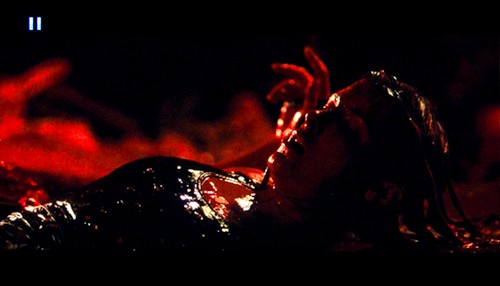
2D Blu-ray Disc movies are a total joy to behold on the Panasonic TX-P42GT30B, whether it’s displaying in the [THX] picture preset, or a finely-tuned [Professional] calibration mode. The biggest reason for this is the GT30’s screen coating, which allows it to reject ambient light and deliver deep blacks in standard viewing environments. Importantly, the TX-P42GT30B also delivers a completely uniform level of black across the entire panel, and does so regardless of where the user is sitting. This is a Plasma television, so these two attributes are to be expected – but they’re still worth celebrating. These deep, uniform blacks act as a canvas for accurate, vibrant colours. The entire image appears silky due to the glass panel and deep blacks, but at no expense to detail and texture. There is no unwanted film grain reduction, meaning that textured, detailed film discs remain textured and detailed when played back through the TX-P42GT30 – a huge relief after witnessesing some other displays which turn film grain patterns into an unattractive paste-like smear. Of course, it’s not perfect (we explained our findings relating to “floating blacks” in the “Black Level” section of this review, and we know that very fast motion will cause some artefacting), but the 2D picture quality delivered by the TX-P42GT30B is absolutely excellent.
The TXP42GT30 retains Panasonic’s signature “clean” Plasma look: the Plasma panel’s driving method results in only a very small amount of fine noise being added to the image. Oddly, we did notice that when we displayed static, single-tone test patterns, the top 100 or so lines of the GT30 displayed a higher amount of subtle noise compared to the rest of the image. We’re not sure what the cause of this is or if it affects every unit, but we mention it for completeness only (we weren’t troubled by it).
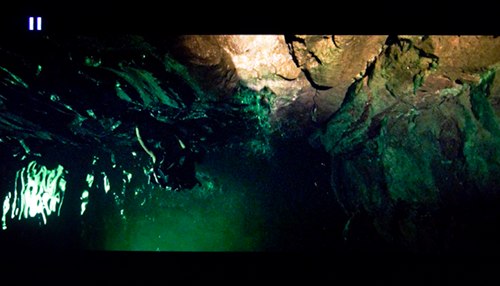
There is another, more subtle improvement under the hood when compared to last year. When we ran Chroma Resolution test charts from a Blu-ray Disc source through 2010’s Panasonic Plasmas, we noticed that the thin red and blue horizontal lines in the test pattern were not distinct, and instead were smudged into a more purple-ish tone. Although not a huge issue, it was ironic, given that compared to other TV makers, Panasonic is unusually vocal in promoting high quality chroma processing whenever it sells its Blu-ray Disc players! Blu-ray Disc and other consumer video formats use a 4:2:0 sampling system, meaning that they display 1920×1080’s worth of luminance detail, but only 960×540’s worth of colour. The TX-P42GT30B can display all of the detail present in a 4:2:0 signal, which is an improvement on last year. In practice, this will go unnoticed by nearly everyone, but it does mean that tiny coloured details will be reproduced more faithfully on the TX-P42GT30.
Input lag on the TX-P42GT30B measured at around 24ms in the “Game” picture mode, which is one of the better results we’ve measured from an HDTV recently. It’s not as lightning-quick as some of the more basic Panasonic displays, though, for users who are extremely sensitive to lag. We also didn’t notice any image retention sticking around after gaming sessions, but if you do end up with a latent reminder of your victories (or defeats) sticking around on screen, the “Scrolling Bar” is readily accessible from the TX-P42GT30’s menu and should clear things up.
The sticker attached to our Panasonic TX-P42GT30B promises that this HDTV is “Perfect for 2D & 3D”. It’s not perfect, but it is excellent, and we can’t think of anything better in this price range. Its NeoPlasma panel and light-rejecting screen coating allow it to produce deep, vivid images with colour that manages to be both accurate and vibrant, without the need for a darkened viewing environment (although we would still advise potential buyers to look into LCD TVs if performance in a very bright room is important, because the GT30’s images are not necessarily bright).
The reasonably accurate Greyscale performance that the TX-P42GT30 produced “out of the box” in the THX picture mode meant that images were largely free of unwanted colour casts, without any specialised calibration work being necessary. Of course, that’s also an option for users who want to squeeze every last drop of performance from the plasma TV.
However, the biggest improvements this year are in the area of 3D performance. While last year’s Panasonic 3DTVs produced a very reddish 3D image (which could be countered somewhat using highly expensive, specialised calibration equipment, out of the reach of nearly all users), the TX-P42GT30B produced a suitably natural, consistently coloured tri-dimensional image out of the box – something we can probably thank the THX Display Certfication programme for. As with Panasonic’s first 3D Plasma TVs, crosstalk artefacts (double images with 3D material) are kept to a minimum. There is still some obivous panel-generated (not source-specific) noise during 3D playback, though, as well as some jaggedness during 3D motion. Buyers should keep in mind that the 50-inch Panasonic TX-P50GT30B will probably be free of the latter issue, and will also deliver a more immersive 3D experience due to the larger screen size, anyway.
The TX-P42GT30 isn’t without flaws, but in this reviewer’s opinion, dwelling for too long on these would be to miss the forest for the trees, because no other flat-panel TV in this price range produces such rich and consistent blacks. The Panasonic TX-P42GT30B produces high quality, detailed, accurate video in 2D and 3D, and we feel that the price is right. As such, we think it belongs in the “Highly Recommended” category.
